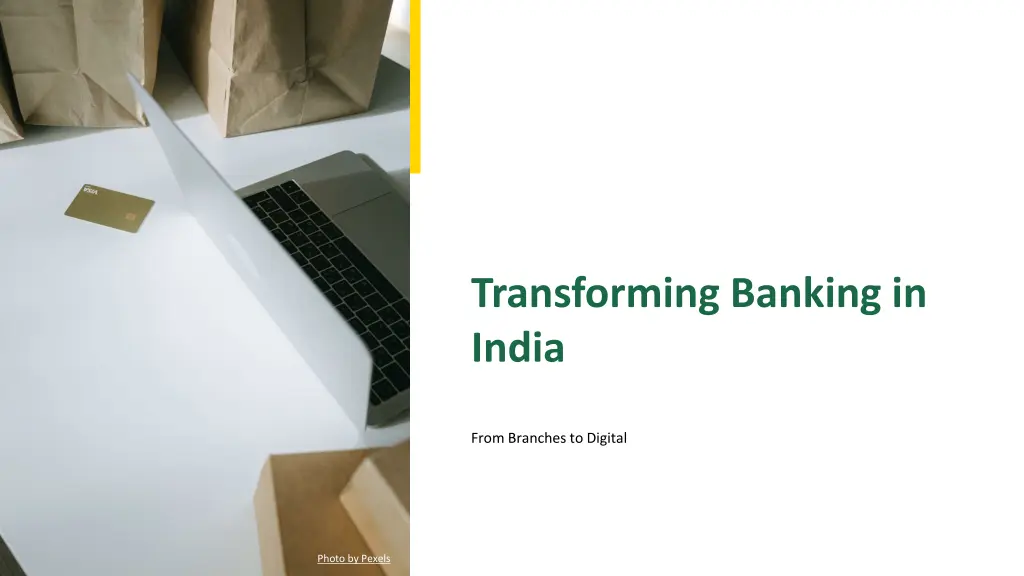
Digital Transformation of Banking in India: Embracing a New Era
"Explore the monumental shift in India's banking sector from traditional branches to digital innovation. Discover key catalysts, rise of mobile banking, defined digital banking services, and how traditional banks are adapting to changing customer preferences. Government initiatives, smartphone surge, and future trends play vital roles in this transformative journey."
Download Presentation

Please find below an Image/Link to download the presentation.
The content on the website is provided AS IS for your information and personal use only. It may not be sold, licensed, or shared on other websites without obtaining consent from the author. If you encounter any issues during the download, it is possible that the publisher has removed the file from their server.
You are allowed to download the files provided on this website for personal or commercial use, subject to the condition that they are used lawfully. All files are the property of their respective owners.
The content on the website is provided AS IS for your information and personal use only. It may not be sold, licensed, or shared on other websites without obtaining consent from the author.
E N D
Presentation Transcript
Transforming Banking in India From Branches to Digital Photo by Pexels
01 A New Era in Banking Table of Contents 02 The Catalysts of Change 03 Rise of Mobile Banking 04 Digital Banking Defined 05 Traditional Banks Respond 06 Changing Customer Preferences 07 Efficiency through Innovation 08 Challenges Ahead 09 Future Trends in Banking 10 Thank You!
1 A New Era in Banking Embracing Change The banking landscape in India is undergoing a monumental shift from traditional methods towards digital innovation, embracing a new era of financial services. As of 2024, India boasts over 150,000 bank branches, which have long served as the backbone of our financial infrastructure. However, the rapid advancement of digital banking is redefining how consumers interact with their money and financial institutions. This transformation is not just a trend; it's a fundamental change in how we view banking in the digital age. Photo by Pexels
2 The Catalysts of Change Government Initiatives Key initiatives like Digital India and the Pradhan Mantri Jan Dhan Yojana (PMJDY) are major catalysts igniting the digital banking revolution. These initiatives aim to enhance financial inclusion, providing access to banking services for millions across the country. With internet penetration exceeding 700 million users by 2023, the stage is set for a digital banking boom. Government support has made digital banking accessible and appealing to a wider population. Photo by Pexels
3 Rise of Mobile Banking Smartphone Surge The number of mobile internet users in India is set to reach 770 million by 2024, paving the way for flexible banking solutions. Mobile banking empowers users to manage finances anytime, anywhere, shiftingcontrol to the consumer. Smartphones are playing a pivotal role in bridging the banking gap for many, especially in urbanareas. This mobile trend is reshaping traditional banking practices and customer expectations. Photo by Pexels
4 Digital Banking Defined More Than Convenience Digital banking encompasses both online and mobile banking, redefining the consumer experience. It s about convenience, efficiency, and personalized services tailored to individual needs. With technological advancements and government backing, the banking landscape is evolving swiftly. This evolution aims to enhance user satisfaction and operational efficiency for banks. Photo by Pexels
5 Traditional Banks Respond Adapting to Change In response to digital trends, traditional banks are strategically reducing branch networks to focus more on digital channels. Leading banks like SBI and ICICI are closing less profitable branches to invest in robust digital infrastructures. This transition helps banks remain competitive in an increasingly digital marketplace. The goal is to ensure that customers receive the best services throughboth digital and physical channels. Photo by Pexels
6 Changing Customer Preferences The Voice of the Customer A Deloitte survey reveals that 72% of urban customers now prefer digital banking over traditional methods. This shift in preference emphasizes the need for banks to enhance their digital offerings to meet customer demands. Understanding consumer behavior is critical for banks aiming to thrive in this new environment. Customer-centric approaches will drive the future of banking in India. Photo by Pexels
7 Efficiency through Innovation Quantifiable Benefits Digital innovations have led to significant operational efficiencies, transforming how banks operate. HDFC Bank reports a 30% reduction in processing times, thanks to digital upgrades. Moreover, the bank has experienced a significant 40% decrease in operational costs throughthese innovations. Efficiency gains enable banks to serve customers better while maintaining profitability. Photo by Pexels
8 Challenges Ahead Navigating Risks Despite advancements, the banking sector faces challenges like digital literacy gaps and cybersecurity threats. Maintaining customer trust in the face of evolving cyber threats is paramountfor banks. Furthermore, adapting to ever-changing regulatory requirements can be complex and time-consuming. Addressing these challenges will be crucial for sustainable growth in digital banking. Photo by Pexels
9 Future Trends in Banking Innovative Outlook Looking ahead, the banking sector will likely witness further digital adoption fueled by increased internet and smartphone access. Emerging technologies such as AI, blockchain, and 5G stand to revolutionize banking services. Collaboration with fintech companies will drive further innovation and enhance service offerings. Regulatory frameworks must evolve to ensure security and efficiency in digital operations. Photo by Pexels
10 Thank You! Questions & Discussion Thank you for exploring the transformative journey of banking in India with us! We hope this presentation has inspired you to embrace the future of digital banking. Feel free to ask any questions or share your thoughts on this exciting transition. Photo by Pexels
